20060910 Bear-o-rama Brouhaha
The management of Katmai National Park has changed quite a bit over the years. The park has its roots in Katmai National Monument, created by Woodrow Wilson in 1918 solely to protect volcanic resources. Brooks Camp did not exist at the time and would not have been in the monument anyway. In 1931 Herbert Hoover enlarged the monument to a size that included today’s Brooks Camp, which still did not exist. Finally in 1950 Brooks Camp came to be, originally a fly-in fish camp. Not many bears were around at the time and any that were likely were chased away or worse. There were not many park rangers around either.
About four decades after the establishment of Brooks Camp, brown bear numbers [the park has no black bears] around Brooks River increased dramatically and the bear viewing business increased right along with it. While I do not have the numbers, my impression is that today far more people come to Brooks to watch the bears fish than to fish themselves. Without doubt more come to do either of those than to visit the volcano area, which has ironically become a sidelight.

Today 300 people or more may visit Brooks Camp in a single day, spending hundreds if not thousands of dollars for the privilege. Generally these folks are free to move around provided they observe the 50-yard rule. Visitors must not remain within 50 yards of a bear, unless the visitor is on a viewing platform. If a bear approaches within 50 yards, visitors must give ground. Visitors may not approach a bear to within 50 yards.
Human safety is one concern, but not the only one, which manifests itself in the 50-yard rule. Bears habituated to close contact with people may find themselves in trouble in areas where bears are hunted, as well as in civilized areas like the town of King Salmon, 30 miles away, where residents may shoot bears legally in defense of life and property.

Experience tells us that not all people will obey this rule voluntarily. To assist them with compliance, for their safety and that of the bears, throughout the day rangers are posted on either side of the lower portion of Brooks River, at the “corner”

and at the “lower river platform.” Law enforcement rangers and bear management rangers, known as bear techs, rove the area as well.

Rangers will close a portion of the sometimes-busy travel path from the lodge, on the north side of the river, to the lower river platform on the south side should bears be closer than 50 yards. The 80-yard-long floating bridge across the river may be closed, the corner may close, or both.
In July, when the salmon are moving upstream and jumping Brooks Falls, most bears spend most of their river time at the falls. Still, some bears use the lower river in July and those bears often breach the 50-yard limit along the travel path necessitating closure to human traffic. People move almost without delay in August as most bears leave Brooks River for places unknown. Come September, after a month absent, many bears return.
At this time they spend little time at the falls, as few or no fish are jumping. Rather they congregate in the half-mile or so of the lower river eating dead and dying sockeye. Thus they are even more often in the vicinity of the human travel path in September than in July. In September the travel path may be closed more than it is open. Day-use folks may spend two or three of their five or six hours at Brooks waiting to access the prime viewpoint offered by the lower river platform. While the visitors do not seem to complain as much in September as they do in July—often many bears may be seen from the corner without crossing the bridge and most visitors ultimately see beaucoups bears—other people are not exactly thrilled with the arrangement.
Katmailand, operator of Brooks Lodge, finds its guests unable to cross the river to purchase meals and to board aircraft. On east wind days, like yesterday, the planes land, not at Naknek Lake right in front of the lodge, but at Brooks Lake 1.5 miles away and on the opposite side of the river. Then, not only are the guests unable to reach the lodge, lodge staff are unable to transport their baggage to the rooms.

Katmailand’s bus tour to the Valley of Ten Thousand Smokes departs from the lower river platform on the opposite side of the river from camp. Over the past several days, as more and more bears arrive at the river for the dead salmon festival, the tour departs less and less at its scheduled 9 a.m. More than once the tour has not been able to leave until 11:00 or later because participants were caught at the corner unable to cross the bridge. One day it drove away at 1:30. This is a tour for which folks pony up almost $100. Some participants have asked for refunds, which does not please lodge management.
Our maintenance folks bristle as well. The bridge closures eat into their productivity if a project requires that they cross the bridge. They may also find themselves late to work as most live at Lake Brooks housing on the opposite side of the river from camp. At the end of a workday they may not be able to return home for an hour or more.
Some of the dissatisfaction stems from the way platform and corner rangers, usually interpreters like myself, execute their duties. At training the interpretive supervisor used a rangefinder to demonstrate 50 yards. Part way through the season he repeated rangefinder sessions to reinforce accurate assessments of 50 yards distance from key points along the travel path and bridge. Still, critics charge, and not unwarrantedly so, that different rangers have different perceptions of 50 yards, and that most err on the conservative side.
During pre-season interpreter training, safety was emphasized. “We want you to go home at the end of the day with all of your body parts intact.” With most of the staff new and much of it young, early on interpretive rangers were loath to take risks in opening the bridge too soon, before a bear had cleared the area, and possibly sending visitors into harm’s way.
The great unsaid, but I suspect thought by many around camp with more experience than me, is that nothing will happen even if we get close to bears. This may be true. Most of these bears grew up in Brooks around people. They are naturally well fed. They display an amazing degree of tolerance for the mistakes that we make every day. Only two people have been injured since 1966, neither seriously.

Still, no one wants to be the ranger who, in response to pressure to get people moving, hastily announces “Bridge open!” only to have a visitor mauled by an unseen bear that may have been seen had more time been taken to scan the area. Visitors are told that ultimately they are responsible for their own safety, but should a visitor be injured or worse on my watch my conscience would torment me for a long, long time.

What is the park doing about these bear traffic delays? According to our bear management plan, in the camp area proper--defined by buildings--bear management and law enforcement rangers haze trespassing bears. Once beyond the buildings area perimeter, bears are left alone to access an important food resource. Humans must yield right of way to bears outside of the buildings area. Hazing of bears in their area occurs only as a last resort, when all other options have been exhausted.
The first option is waiting. We just wait for a bear sleeping along the path to move on its own. When an active bear, and sometimes several active bears, are within 50 yards of the travel path or bridge, we monitor and open the path at such time as all bears have moved off to a distance of 50 yards or more. Fifteen or more bears at a time may be using the lower river in September, so this can take a while. Recently eight bears fished in the river or stood on the shore within 50 yards of the corner alone.
Another option is an alternate travel route. Can we use the beach or a secondary path to avoid a bear sleeping beside the main path? Can an airplane taxi to the other side of the river, or even fly to nearby Lake Brooks, to load passengers? Can the visitors be transported by boat?
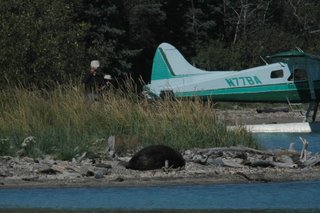
Sometimes the 50-yard rule is waived. A bear technician or law enforcement ranger will generally make this decision, based on the situation and the bear or bears involved. This is most often used when the too-close bear is asleep and is 20 yards or more from the travel path.

If an individual bear or family group has been sleeping in the same spot for a considerable time, bear management staff may elect to move the bear or bears.

This decision may be hastened by the need to move passengers with imminent connecting flights. Cubs waiting at the shore while mom fishes in the river, a common September scenario, would not be moved.

Katmailand is not at all happy with how the park service manages bears and people. I would be too was I the lodge manager. National Park Service bear management policy disrupts business virtually every day of the bear viewing season.

Based upon remarks made almost daily by some lodge staff, it seems that Katmailand would prefer that bears be hazed immediately whenever they impede human travel. They say that, because we do not haze bears on the travel path, we are training bears to use it. I must say I see some truth there, but at the moment the park service maintains bear use trumps human use.
Just as a lack of hazing may encourage the bears to use the travel path, hazing may teach them to avoid it entirely and move upstream away from the viewing area. Without a chance at a close look at a bear, surely fewer people would come to Brooks. Katmailand may be better off without the hazing.

As evidenced by an NPS planning document, the park service believes that moving camp to the opposite side of the river, out of major bear travel areas, would be a long-term solution to most of the human travel problems. However, this possible solution brings with it its own set of problems relating to a private inholding nearby, floatplane access, wetlands, and more. A number of alternative destinations have been identified, but the park has not moved to implement any one of them. Katmailand, on board with the move idea early on, is no longer willing to cooperate. The concessionaire, with powerful friends, currently blocks the move.
Another alternative for opening the lid on bear jams would be to construct an elevated walkway the entire distance from the lodge area to the opposite side of the river. Some people object, citing the impact on the Brooks River viewshed.
This brouhaha over managing the Brooks Camp bear-o-rama has been boiling for years. “The Skinny,” a ranger logbook for passing on topical information from one shift to the next, contains 1995 and earlier references to the very same issues we experience today. Will it continue indefinitely?
Over the last few days a committee of three men, all with bear experience but not employees of the park, has been interviewing park staff about the bear management situation at Brooks. The committee wants to document the day-to-day implementation of the park’s bear management plan and to hear our concerns and suggestions. At this point I do not know who hired these men nor do I know the chain of events that led to them being here. While I am not in a position to be certain, their presence suggests that once again a management change is coming to Katmai.
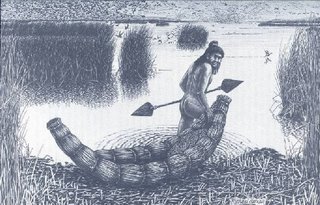 For hundreds of years the tidal salt marshes of south San Francisco Bay provided habitat for a multitude of living things, including humans. The Ohlone people not only harvested fish and wildlife from the area, they harvested salt. Later, European-descended people continued the salt tradition.
For hundreds of years the tidal salt marshes of south San Francisco Bay provided habitat for a multitude of living things, including humans. The Ohlone people not only harvested fish and wildlife from the area, they harvested salt. Later, European-descended people continued the salt tradition. The Refuge and its partners seek to restore many of the salt ponds to natural tidal marshes and have already been successful with a few.
The Refuge and its partners seek to restore many of the salt ponds to natural tidal marshes and have already been successful with a few. Instead, one by one several of the ponds are being opened to the tide once again.
Instead, one by one several of the ponds are being opened to the tide once again.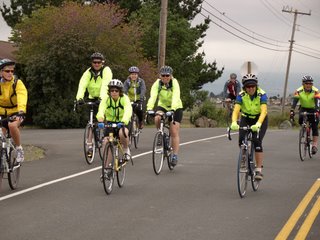 The general public benefits from the Refuge and its neighbor to the north, Coyote Hills Regional Park. A network of biking/hiking trails links the two and provides miles of much needed outdoor recreation in a densely populated area.
The general public benefits from the Refuge and its neighbor to the north, Coyote Hills Regional Park. A network of biking/hiking trails links the two and provides miles of much needed outdoor recreation in a densely populated area. The US Fish and Wildlife Service would like the public to understand that the Refuge has more than just recreational significance.
The US Fish and Wildlife Service would like the public to understand that the Refuge has more than just recreational significance.  The Fremont headquarters and visitor center tells the restoration story to the general public while a few miles away in Alviso local students participate in environmental education programs.
The Fremont headquarters and visitor center tells the restoration story to the general public while a few miles away in Alviso local students participate in environmental education programs.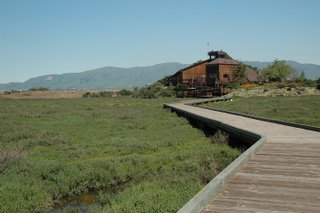 For the past couple of years Tia has been involved in the former and soon will switch to the latter.
For the past couple of years Tia has been involved in the former and soon will switch to the latter. Staff generally lives offsite, but some do live in "Trailerville," a motley collection of travel trailers and modular houses set in the headquarters maintenance yard. Tia lives there in what she calls her "tuna can", a thirteen-year-old 36’ Dutchman trailer.
Staff generally lives offsite, but some do live in "Trailerville," a motley collection of travel trailers and modular houses set in the headquarters maintenance yard. Tia lives there in what she calls her "tuna can", a thirteen-year-old 36’ Dutchman trailer.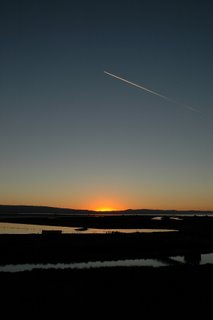 I am grateful that the Big Yellow Taxi stops here.
I am grateful that the Big Yellow Taxi stops here.







 Pilot Chris, flying the Otter beneath the low ceiling,
Pilot Chris, flying the Otter beneath the low ceiling, 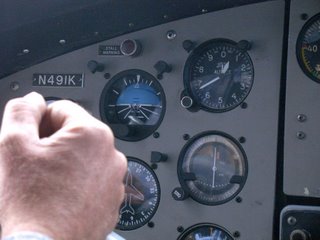
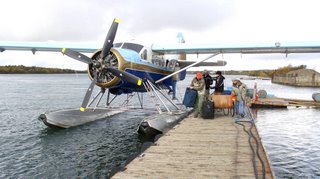

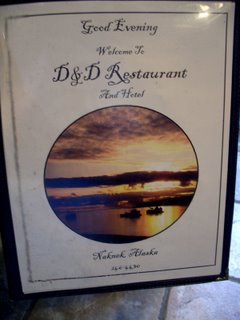
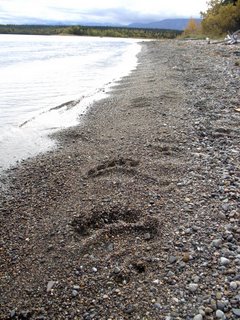
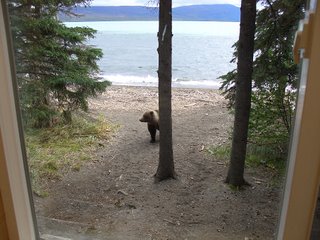
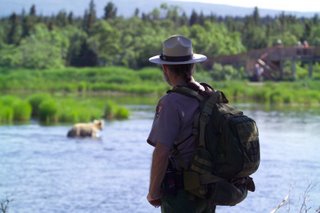
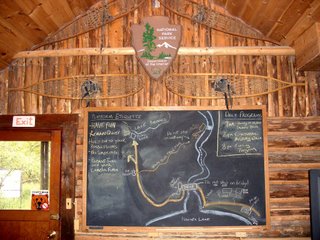

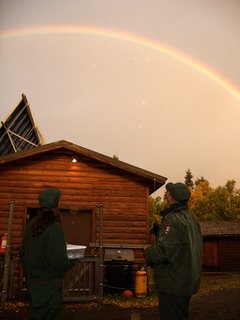
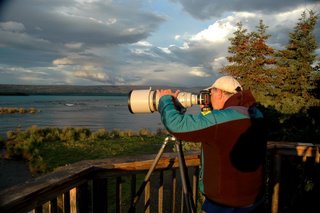

















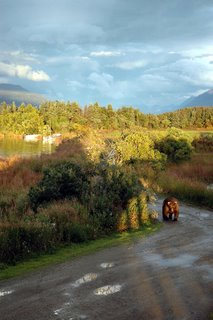


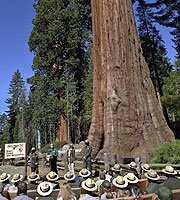



.jpg)
